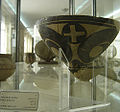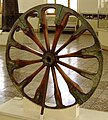Iranian National Museum
The National Museum of Iran ( Mūze-ye Mellī-ye Irān ( Persian موزه ملي ايران) or Muze-ye Irān-e Bāstān ( Persian موزه ایران باستان) Museum of Iran of Antiquity ) is an archaeological and historical museum in Tehran .
The museum consists of two buildings, each with three halls, in which artefacts from pre-Islamic and Islamic times are exhibited. The first building was designed by André Godard based on the Sassanid Taq-e Kesra in Ctesiphon and inaugurated in 1937. Here you can find exhibits from the early Paleolithic to the Sassanid period. The second building dates from 1996. Here you can find art and text products from the Islamic period.
The museum has research departments for the Paleolithic and Achaemenid periods as well as a center for ceramic research .
Exhibitions
The oldest artifacts in the museum come from archaeological sites in Kaschafrud , Darband and Ganj Par , which date back to the Old Paleolithic . In the first hall are from Neanderthals created moustérienische stone tools to see. The most important tools come from the Yafteh Cave in Lurestan and go back to around 30–35,000 years ago. The many exhibits also include 8,000-year-old human and animal figures from Tappeh Sarab in Kermanshah . A life-size figure of Darius I , made in Egypt and found in Susa, is also on display in the museum.
In the Islamic part of the museum excavation and collectibles are on display. In addition to a section with Korans , there are other areas with book manuscripts , Persian miniature paintings from various miniature schools such as those of the Shiraz , Isfahans , Herater and Indian painting schools as well as those of the Mughal Empire .
Furthermore, exhibits on astronomy can be seen, such as astrolabe . There are also departments with handicrafts such as ceramics , textiles and metal crafts .
Some parts of the permanent exhibition are regularly loaned to museums such as the British Museum .
Illustrations
A decorative bowl from the 4th millennium BC from the province of Fars
A spoked wheel from the 2nd millennium BC from Tschoga Zanbil
Bowl of Kashan , 14th century
Gold ring from the tomb of Arjān
Bust from the manor at Hājīābād
Web links
Individual evidence
- ↑ cf. Article in the Caroun web link
Coordinates: 35 ° 41 ′ 13.4 " N , 51 ° 24 ′ 52.7" E







